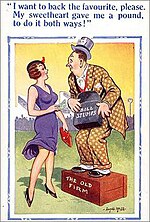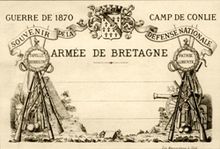history of Postcards
A postcard or post card is a rectangular piece of thick paper or thin cardboard intended for writing and mailing without an envelope.[1] In some places, it is possible to send them for a lower fee than for a letter. Stamp collectors distinguish between postcards (which require astamp) and postal cards (which have the postage pre-printed on them). While a postcard is usually printed by a private company, individual or organization, a postal card is issued by the relevant postal authority. The United States Postal Service defines a postcard as: rectangular, at least 31⁄2 inches (88.9 mm) high × 5 inches (127 mm) long × 0.007 inches (0.178 mm) thick and no more than 41⁄4 inches (108 mm) high × 6 inches (152.4 mm) long × 0.016 inches (0.406 mm) thick.[2] However, some postcards have deviated from this (for example, shaped postcards).
 In 1973 the British Post Office introduced a new type of card, PHQ Cards, popular with collectors, especially when they have the appropriate stamp affixed and a First day of issuepostmark obtained.
In 1973 the British Post Office introduced a new type of card, PHQ Cards, popular with collectors, especially when they have the appropriate stamp affixed and a First day of issuepostmark obtained.
 In the early 1930s, cartoon-style saucy postcards became widespread, and at the peak of their popularity the sale of saucy postcards reached a massive 16 million a year. They were often bawdy in nature, making use of innuendo and double entendres and traditionally featured stereotypicalcharacters such as vicars, large ladies and put-upon husbands, in the same vein as the Carry On films. In the early 1950s, the newly electedConservative government were concerned at the apparent deterioration of morals in Britain and decided on a crackdown on these postcards. The main target on their hit list was the renowned postcard artist Donald McGill. In the more liberal 1960s, the saucy postcard was revived and became to be considered, by some[who?], as an art form. This helped its popularity and once again they became an institution. However, during the 1970s and 1980s, the quality of the artwork and humour started to deteriorate and, with changing attitudes towards the cards' content, the demise of the saucy postcard occurred. Original postcards are now highly sought after, and rare examples can command high prices at auction. The best-known saucy seaside postcards were created by a publishing company called Bamforths, based in the town of Holmfirth, West Yorkshire, England. Despite the decline in popularity of postcards that are overtly 'saucy', postcards continue to be a significant economic and cultural aspect of British seaside tourism. Sold by newsagents and street vendors, as well as by specialist souvenir shops, modern seaside postcards often feature multiple depictions of the resort in unusually favourable weather conditions. John Hinde, the British photographer, used saturated colour and meticulously planned his photographs, which made his postcards of the later twentieth century become collected and admired as kitsch. Such cards are also respected as important documents of social history, and have been influential on the work of Martin Parr.
In the early 1930s, cartoon-style saucy postcards became widespread, and at the peak of their popularity the sale of saucy postcards reached a massive 16 million a year. They were often bawdy in nature, making use of innuendo and double entendres and traditionally featured stereotypicalcharacters such as vicars, large ladies and put-upon husbands, in the same vein as the Carry On films. In the early 1950s, the newly electedConservative government were concerned at the apparent deterioration of morals in Britain and decided on a crackdown on these postcards. The main target on their hit list was the renowned postcard artist Donald McGill. In the more liberal 1960s, the saucy postcard was revived and became to be considered, by some[who?], as an art form. This helped its popularity and once again they became an institution. However, during the 1970s and 1980s, the quality of the artwork and humour started to deteriorate and, with changing attitudes towards the cards' content, the demise of the saucy postcard occurred. Original postcards are now highly sought after, and rare examples can command high prices at auction. The best-known saucy seaside postcards were created by a publishing company called Bamforths, based in the town of Holmfirth, West Yorkshire, England. Despite the decline in popularity of postcards that are overtly 'saucy', postcards continue to be a significant economic and cultural aspect of British seaside tourism. Sold by newsagents and street vendors, as well as by specialist souvenir shops, modern seaside postcards often feature multiple depictions of the resort in unusually favourable weather conditions. John Hinde, the British photographer, used saturated colour and meticulously planned his photographs, which made his postcards of the later twentieth century become collected and admired as kitsch. Such cards are also respected as important documents of social history, and have been influential on the work of Martin Parr.
Early history of postcards
Cards with messages had been sporadically created and posted by individuals since the creation of postal services. The earliest known picture postcard was a hand-painted design on card, posted in London to the writer Theodore Hook in 1840 bearing a penny blackstamp. He probably created and posted the card to himself as a practical joke on the postal service, since the image is a caricature of workers in the post office.[3][4] In the United States, a picture or blank card stock that held a message and sent through the mail at letter rate first began when a card postmarked in December 1848 contained printed advertising on it.[5] The first commercially produced card was created in 1861 by John P. Charlton of Philadelphia, who patented a postal card, selling the rights to Hymen Lipman, whose postcards, complete with a decorated border, were labeled "Lipman's postal card." These cards had no images. In Britain postcards without images were issued by Post Office, and were printed with a stamp as part of the design, which was included in the price of purchase. The first known printed picture postcard, with an image on one side, was created in France in 1870 at Camp Conlie by Léon Besnardeau (1829–1914). Conlie was a training camp for soldiers in the Franco-Prussian war. They had a lithographed design printed on them containing emblematic images of piles of armaments on either side of a scroll topped by the arms of the Duchy of Brittany and the inscription "War of 1870. Camp Conlie. Souvenir of the National Defence. Army of Brittany".[6] While these are certainly the first known picture postcards, there was no space for stamps and no evidence that they were ever posted without envelopes.[7] In the following year the first known picture postcard in which the image functioned as a souvenir was sent from Vienna.[8] The first advertising card appeared in 1872 in Great Britain and the first German card appeared in 1874. Cards showing images increased in number during the 1880s. Images of the newly built Eiffel Tower in 1889 and 1890 gave impetus to the postcard, leading to the so-called "golden age" of the picture postcard in years following the mid-1890s.Early US postcards
The first American postcard was developed in 1873 by the Morgan Envelope Factory of Springfield, Massachusetts.[9][10] Later in 1873, Post Master John Creswell introduced the first pre-stamped "penny postcards". These first postcards depicted Interstate Industrial Exposition that took place in Chicago.[11] Postcards were made because people were looking for an easier way to send quick notes. The first postcard to be printed as a souvenir in the United States was created in 1893 to advertise the World's Columbian Expositionin Chicago. The Post Office was the only establishment allowed to print postcards, and it held its monopoly until May 19, 1898, when Congress passed the Private Mailing Card Act, which allowed private publishers and printers to produce postcards. Initially, the United States government prohibited private companies from calling their cards "postcards", so they were known as "souvenir cards". These cards had to be labeled "Private Mailing Cards". This prohibition was rescinded on December 24, 1901, when private companies could use the word "postcard". Postcards were not allowed to have a divided back and correspondents could only write on the front of the postcard. This was known as the "undivided back" era of postcards. On March 1, 1907 the Post Office allowed private citizens to write on the address side of a postcard. It was on this date that postcards were allowed to have a "divided back".[11] On these cards the back is divided into two sections, the left section being used for the message and the right for the address. Thus began the Golden Age of American postcards, which lasted until 1915, when World War I blocked the import of the fine German-printed cards. Postcards, in the form of government postal cards and privately printed souvenir cards, became very popular as a result of the Columbian Exposition, held in Chicago in 1893, after postcards featuring buildings were distributed at the fair. In 1908, more than 677 million postcards were mailed. The "white border" era, named for obvious reasons, lasted from about 1916 to 1930. Valentino ManurungContemporary postcards
The last and current postcard era, which began about 1939, is the "chrome" era, however these types of cards did not begin to dominate until about 1950. The images on these cards are generally based on coloredphotographs, and are readily identified by the glossy appearance given by the paper's coating. These still photographs made the invisible visible, the unnoticed noticed, the complex simple and the simple complex. The power of the still photograph forms symbolic structures and make the image a reality.[12]
A tinted (black and white image that has had colored tint added) souvenir card. Image of the Christopher Columbus taken circa 1896
[edit]Postcards in British India
In July 1879, the Post Office of India introduced a 1/4 anna postcard that provided postage from one place to another within British India. This was the cheapest form of post provided to the Indian people to date and proved a huge success. The establishment of a large postal system spanning India resulted in unprecedented postal access where a message on a postcard could be sent from one part of the country to another part (often to a physical address without a nearby post office) without additional postage affixed. This was followed in April 1880 by postcards meant specifically for government use and by reply post cards in 1890.[13]:423-424 The postcard facility continues to this date in independent India.British seaside postcards
In 1894, British publishers were given permission by the Royal Mail to manufacture and distribute picture postcards, which could be sent through the post. The first UK postcards were produced by printing firm Stewarts of Edinburgh and early postcards were pictures of famous landmarks, scenic views, photographs or drawings of celebrities and so on. Withsteam locomotives providing fast and affordable travel, the seaside became a popular tourist destination, and generated its own souvenir-industry: the picture postcard was, and is, an essential staple of this industry.
A typical "saucy" postcard by Donald McGill




